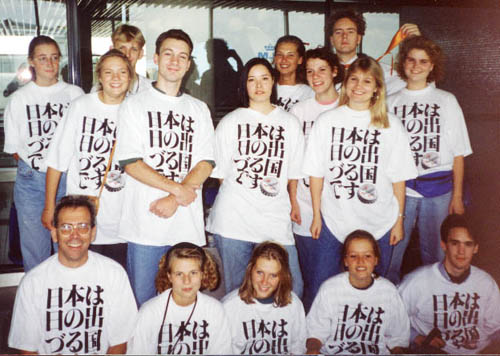
Studying Japanese in Japan is by no means uncommon. Neither is being a Dutch student in a Dutch environment. But studying Japanese in a Dutch environment in Japan is quite another thing. Since 1992, the Department of Japanese Culture and Language of Leiden University has a branch in the replica Dutch town named ‘Huis Ten Bosch’ in Nagasaki, Japan.
If a first-year student in Holland works very hard at Japanese and ends in the top twenty for his or her year, he or she is able to follow the second year of his or her studies in Japan. I managed to do this in my first year so that I was offered this possibility through the idealism of the then-president of Huis Ten Bosch, Mr. Y. Kamichika and the head of the Japanese Faculty Professor W.Boot.2. MOTIVATION
As a devotee of Igo, a Japanese game of skill, I heard that Japanese was one of the most difficult of all languages to study. However, being given a second change to study again at age 39, I decided to set my mind to it. I would be able to communicate with the world’s leading players who visit Europe every year during the European championship, and their vast literature would no longer be ‘puzzling’ to me. Also I might be able to find numerous interesting new jobs. My ideas about Japanese language were confirmed, a bit less than half the students dropping out during the first year. You encounter completely new sounds with no relation to English, French, German or Dutch. The complicated writing system of Japanese katakana, hiragana and kanji makes you respect the genius who thought of our 26 letter alphabet. The grammar, luckily, is not all that difficult but you have to get used to leaving out objects whenever possible, and always be mindful of the level of politeness to be used. After having put in much effort in the first year and still not being able to conduct a conversation with a native speaker, there is no better motivation than studying the second year in Japan. Most foreign students have to study at Japanese universities, which becomes only effective after they have mastered the language pretty well, but that was just what we came to Japan for. The second year of the Japanese course at Huis Ten Bosch is taught in much the same way as in Leiden, with the same exams, but with much added value. Every day Huis Ten Bosch being a theme-park attracts lots of tourists, who welcome the opportunity to talk with real Dutch people wearing wooden shoes. Only one should not be surprised if the Japanese want to know how we keep our mills rotating if there is no wind, since all the mills in Huis Ten Bosch work on electricity. 3. OBATARIAN Although the students did not have to work, it was nice to lend a hand now and then, for example with the tulip festival. Dressed in Dutch costume we were expected to hand out tulips which we carried with us in a basket. Thorough as they are, the management planned a half-hour route for each student to walk through the village. Reality proved a bit different. As soon as we put a foot outside the door and the Japanese saw us giving away flowers, we were completely surrounded by them, in thick circles, and hands would be stretched out towards us from all directions, mostly asking for flowers, but the famous ‘obatarian’ (a contraction of obasan, meaning old lady and batallion) would just grab them from the basket, denuding us of our flowers within three minutes. That job was by no means arduous. But mostly upon seeing a Westerner the Japanese show no reaction at all. This disinterest is, as so many things in Japan, only outward, once one approaches them they cordially engage in conversation, and often one ends up with their address and the well-meant invitation to visit them sometime. 4. COMMUNICATION PROBLEMS AND TEMPTATIONS But some students, still hindered by the language problem and probably some shyness, found it difficult to socialize with the Japanese. At times like this a game of Igo comes in handy, it gives one full access to all layers of society, no matter what one’s language ability is. Some other students found the perfect way to communicate: they began to teach English, French, or Dutch to the Japanese employees of Huis Ten Bosch, who live in the same dormitory as us, near the premises of Huis Ten Bosch. The rather strict rules observed here caused some problems. There were separate buildings for men and women, with big signs at the entrances stating that the the opposite sex were forbidden to enter although the Japanese know of the existence of backdoors too. But these were minor things compared to the advantages: swimming pool, fitness-area, sauna, community-room with tatami, a little shop, bar, company restaurant, everything one could wish for was there. Never before I have seen the conditions for being able to study been laid out so completely. The reason I did not pass the year with high marks was therefore probably the outcome of my choice to try to get the best out of being in Japan; sitting in a room studying a book is something one can do anywhere. After one year unfortunately one has to return home, to make room for twenty other students who are given this unique opportunity to fully submerge themselves in Japanese language and culture. I hope that Mr. Kamichika and Professor Boot will continue this project, for however famous the Department of Japanese Language and Culture of Leiden University may be, it will never be rid of its main disadvantage: Leiden is in The Netherlands.